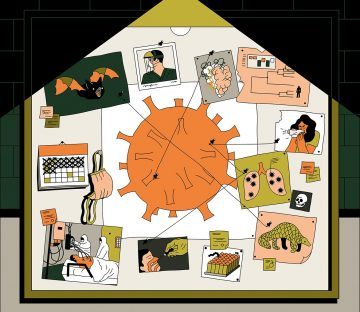David Cyranoski in Nature:
 In 1912, German veterinarians puzzled over the case of a feverish cat with an enormously swollen belly. That is now thought to be the first reported example of the debilitating power of a coronavirus. Veterinarians didn’t know it at the time, but coronaviruses were also giving chickens bronchitis, and pigs an intestinal disease that killed almost every piglet under two weeks old. The link between these pathogens remained hidden until the 1960s, when researchers in the United Kingdom and the United States isolated two viruses with crown-like structures causing common colds in humans. Scientists soon noticed that the viruses identified in sick animals had the same bristly structure, studded with spiky protein protrusions. Under electron microscopes, these viruses resembled the solar corona, which led researchers in 1968 to coin the term coronaviruses for the entire group. It was a family of dynamic killers: dog coronaviruses could harm cats, the cat coronavirus could ravage pig intestines. Researchers thought that coronaviruses caused only mild symptoms in humans, until the outbreak of severe acute respiratory syndrome (SARS) in 2003 revealed how easily these versatile viruses could kill people.
In 1912, German veterinarians puzzled over the case of a feverish cat with an enormously swollen belly. That is now thought to be the first reported example of the debilitating power of a coronavirus. Veterinarians didn’t know it at the time, but coronaviruses were also giving chickens bronchitis, and pigs an intestinal disease that killed almost every piglet under two weeks old. The link between these pathogens remained hidden until the 1960s, when researchers in the United Kingdom and the United States isolated two viruses with crown-like structures causing common colds in humans. Scientists soon noticed that the viruses identified in sick animals had the same bristly structure, studded with spiky protein protrusions. Under electron microscopes, these viruses resembled the solar corona, which led researchers in 1968 to coin the term coronaviruses for the entire group. It was a family of dynamic killers: dog coronaviruses could harm cats, the cat coronavirus could ravage pig intestines. Researchers thought that coronaviruses caused only mild symptoms in humans, until the outbreak of severe acute respiratory syndrome (SARS) in 2003 revealed how easily these versatile viruses could kill people.
Now, as the death toll from the COVID-19 pandemic surges, researchers are scrambling to uncover as much as possible about the biology of the latest coronavirus, named SARS-CoV-2. A profile of the killer is already emerging. Scientists are learning that the virus has evolved an array of adaptations that make it much more lethal than the other coronaviruses humanity has met so far. Unlike close relatives, SARS-CoV-2 can readily attack human cells at multiple points, with the lungs and the throat being the main targets. Once inside the body, the virus makes use of a diverse arsenal of dangerous molecules. And genetic evidence suggests that it has been hiding out in nature possibly for decades. But there are many crucial unknowns about this virus, including how exactly it kills, whether it will evolve into something more — or less — lethal and what it can reveal about the next outbreak from the coronavirus family. “There will be more, either out there already or in the making,” says Andrew Rambaut, who studies viral evolution at the University of Edinburgh, UK.
More here.
